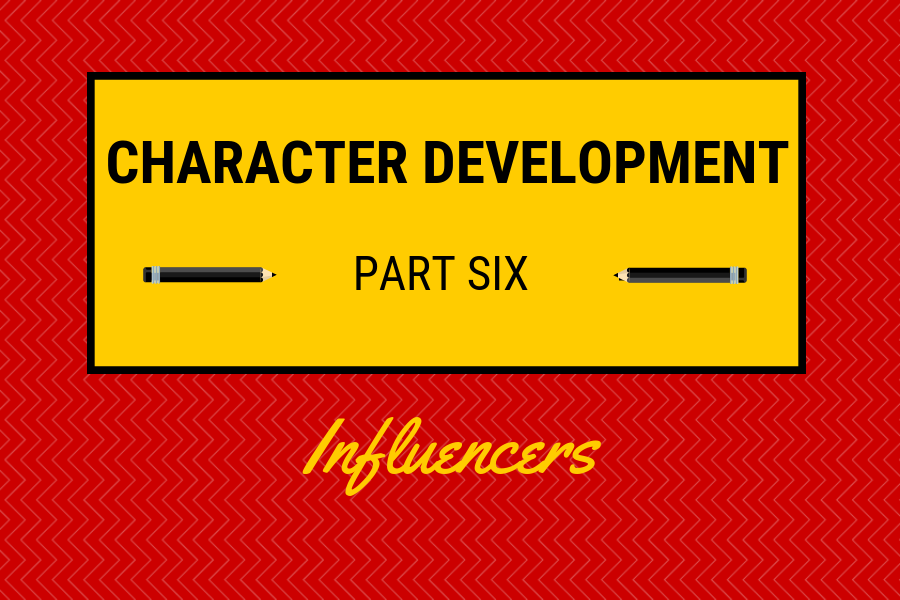This blog is part six of six in a series designed to hone character development of protagonists in your fiction.
After reading through this series, I realize I had written quite a bit about my husband’s opinions. The examples and thoughts expressed reminded me of how immense his influence is on me. I don’t mind that he chooses most of my clothes and likes red lipstick. He’s paying attention!
My family bears significant influence on me. For instance, I promised my youngest daughter I wouldn’t buy Michael Kors brand apparel for myself because she owns several pieces. I never felt comfortable wearing Chanel #5 perfume because Daddy bought it for Momma. I love Beautiful cologne; but, again, Momma wears that and to me, the fragrance belongs to her.
I’ve been influenced in far more substantial ways by women who guided my spiritual and emotional development. The men in my life, past and present, remind me how honorable men at their best can be.
I wish for everyone to be as blessed as I have been by people who are worthy influencers.
Your turn:
Who influences your character? Is this influence positive or negative?
What secondary characters have you set up for your protagonist to interact with? Friends? Family? Both? Why?
What is the most distinctive feature of your favorite secondary character, whether from your work or someone else’s?
What is the biggest challenge you face in creating effective secondary characters?
Character Development Series:



 Keep Your Post-Draft Tasks Distinct
Keep Your Post-Draft Tasks Distinct

At least one of my main characters always seems to be a loner. I do a good deal of internal monologues as a result because they have no secondary character to talk to. I know I shouldn’t overuse that, but I can’t help it! I’d like to learn about how to use secondary characters more effectively.
Keep writing and reading books with strong secondary characters!
I have a lot of internal monologue as well for my MC. The noir stories seem to fit this, such as Nero Wolfe and pretty much anything by Chandler.
However, in my novels most of the MCs have no experience or very little in police procedure, and since I am not at the Agatha Christie level, my MC needs insight with a detective willing to share/teach. That secondary character usually ends up as a love interest, ahem.
A Christian/non-Christian writer who keeps the spiritual within the context, yet many of his characters are not Christians and they are pretty coarse. However in his writing — particularly secondary characters — all have distinct personalities. I’ve read 11 out his 12 books and not one of them has lagged.
So, I do agree with Tamela. Read a lot with good/thick/real secondary characters. Whatever characters do interact with people around, I create an entire profile. This helps me give dialogue and life even if I am not using his/her entire backstory anywhere in the work.
🙂 my 2 cents.
I could never wear White Shoulders cologne because it belonged to my mom. My dad always wore Old Spice when I was growing up. He now wears Aramis cologne. I cook the way my mom did and when I drive I hold the steering wheel in the 3 o’clock & 9 o’clock positions like my dad taught me.
One of my secondary characters is a homeless man who influences my main character by befriending him and helping him see that not all homeless people choose to live on the streets. Some have a story to tell. In this case they influence each other by choosing to let go of the past and live better lives.
Great insights, Loretta!
Great series. Thank you, Tamela.
Glad you enjoyed the series!
Tamela, thank you for this informative series. I’ve loved it and shared it on my Facebook group forum.
To answer your questions, first everyone around me influences my characters. I take bits and pieces from everyone I know and everyone I see to develope my characters, both main and supporting. It’s all good. The characteristics are both good and bad that I observe.
My secondary characters…hmmm…I love so many of them, it’s hard to choose, but I guess I’d have to pick Dr. David Hartley from my recent release. He’s a jovial fellow and deliberately drops cliches into every conversation he can. Of course my book is not filled with cliches but whenever the opportunity for a perfectly times one came up, I had him stick it in. My heroine found it endearing and even told him she knew he did it on purpose. Of course, he admitted to it, to get attention. LOL But I love another supporting character in that book. The heroine’s adoptive sister who is a mischief maker.
I believe the supporting characters are just as important as the main characters. Therefore, I give them my full attention when I set up their characteristics page. The most distinctive physical feature of these two secondary characters are having to go on a diet with Dr. Hartley, and having chestnut colored ringlets in the hair of the sister, plus talking a mile-a-minute.
As far as the biggest challenge I face in creating effective secondary characters, I don’t think I have one. They seem to come naturally. I usually try to make them opposites of the main characters so there’s no confusion in the story.
Sharon, I am honored that you shared my posts! I love your insights, too. Excellent tips, thanks!
I’m indebted to Ken Watanabe (whom I rather resemble) for his portrayal of Lord Katsumoto in “The Last Samurai”, for that character has helped to guide my steps through these fell and frightening days of cancer and its minions.
Fear is experienced by all; fortitude is a choice.
Stay strong, my friend!
He was indeed awesome.
I love using secondary characters to speak truth and encouragement into my main characters’ lives. In my current work-in-progress, there are two older women in my protagonist’s life that encourage her and guide her. I purposely chose women who weren’t her mom, because she has a conflicted relationship with her mom, and for many people, their parents aren’t their source of encouragement, it is a friend, mentor or coworker!
Good idea, Hilary! So sad when parents can’t be as supportive as they should. Perhaps your books will serve as teachers to some readers and encouragement to others.
Amen!
Thank you for another great post, Tamela, and I’m sad the series is over!
My protagonist is influenced by the memories of her deceased sister, and as the story unfolds, secondary characters begin to step in and help her grow spiritually. (Very much a positive thing!) I also bring in another character later on (hinting at him earlier) to show how the protagonist has grown and how God uses her.
Personally, my favorite secondary character (Aunt Nora) has a distinctive feature of reaching out to those in need. She blends her own life, her own family with opportunities to serve others, bringing everyone together on so many levels.
The biggest challenge I’ve had was I had to pull back the reigns a bit. I found myself wanting to follow one of the secondary characters a little too closely, making her more of a focus and steering the story away from the main plot line.
And as I’m writing this, I realize I often use children as secondary characters in my Christmas stories to teach (or remind) Biblical truths. I LOVE doing that!
Blessings to you, Tamela!
When I was writing novels, I let a villain take over a story. I had to do a lot of editing!
Are you sure YOU let him? My characters are pretty strong willed, and we sometimes have a battle of wills on our hands while I’m writing. LOL
I, too, will get “crushes” – for lack of a better word – on various characters in turn as they begin to display their particular qualities in response to events. So, which is my favorite character depends on what part of the story I am currently writing or rewriting.
I asked three different beta readers who their favorite character was, and got three different answers. And there were indeed reasons to admire each of the three and even to think of each as the MC.
Hi Tamela!
I like to add strong influencers into my books who can guide my characters in making good life decisions.
In my book, The Forbidden Gift, there is an older Amish carpenter who is a man of very few words.
Because he is so careful in what he says, my characters recognize that his words have value. And they listen to him.
Debra, your comment reminded me of a ‘man-of-few-words’ story…
In the days before cell phones, a New Yorker had gone for a drive through the back roads of Maine, and his car broke down. Eager to get back to the main road to summon help, he decided to cross a fenced farm field whose sole occupant was a bull.
Halfway across, he saw the farmer leaning on the fence, watching his progress. The city slicker yelled across, “Hey! is that bull safe?”
“Yep, he’s safe,” said the farmer. “Caint say the same for you.”
Too funny, Andrew!
My father was like that, Debra. He didn’t say a lot so when he did give an opinion, people listened. Thanks for the memory.
Thanks so much, Tamela! One of my secondary characters is an English gal who makes weird scones- like corn flake and cheese scones. She was based physically on a gal I knew many years ago who had large skirts that could hid children (she worked in the nursery at church and was known for her propensity for misplacing children under her care.)
Oh my goodness! That sounds like a hoot, except when they’re your kids!
I have a recurring secondary who’s a bad influence. Lucius Fidelis arranged an “accident” that killed his oldest brother to make him first-born. His own second-born son decides that’s a good idea, and that son’s attempt to emulate Dad drives the action in Forgiven. Lucius F. turns his father in as a Christian to get free from his father’s control and to get all the family fortune for himself, cheating his younger brother in The Legacy. When his sister calls him a murderer, he plans to marry her for cash to a particularly nasty person. She runs away to her good brother, and events that follow, including Lucius trying to get her back, drive the plot for that novel. Eight years later, his loyalty to his best friend makes him willing to give his daughter in marriage to the friend’s violent son. His wife decides to divorce him, kidnap their daughter, and run. Lucius’s efforts to get his daughter back are a major subplot in Second Chances. Lucius has been a very useful villain, and he’ll come back again in a year and a half as a main character. He’ll have a chance at redemption, but I don’t know yet if he’ll take it.
Sounds like you can write great villains, Carol!
I love these posts, Tamela and all.
The villians need to be as interesting as the main character (or close). I enjoy secondary characters, however I have found (thus far) that my works are far too long just with the MC’s love interest.
My second novel has the villian as the MC’s close friend, and there is a Hercule Poirot detective who has grown under the tutelage of her love interest.
For me, I believe I recieved a lot of extrovert from my dad, who often spoke his mind, and somewhat harshly at times–truth, just harsh– from my dad, and the introvert and Southern belle politeness from my mother and the homebody. Which results in truth then an apology. But I am ‘volcanic’ when pushed too far. My folks, never.
My differences came from some folk music and classical. John Denver (Oh how funny), his early works, shaped my desire to live in the country. Bake bread, in fact bake lotsa bread. Unlike my culinary mom, other than bread, I couldn’t cook worth a darn until around 2003 when I ate healthy and wrote a cookbook. 🙂
What type of cookbook? I love to cook!
It’s a healthy cookbook kinda old now, but I don’t like to eat ‘diet food’ that is horrible, or pay so much that I can’t afford it (I mean, who can afford saffron??). I want my cake and eat it, too. I want my pizza. Meatloaf. And I’d been through just about every healthy cookbook on the market, and bleh. I had to give up all my favorite foods for bleh foods. My basic plan at the time was to stay out of the ICU since my biological mother had 4 heart attacks when she was in her 30’s or 40’s.
Giving up good food? Not in my lifetime… so I wrote it and mostly just handed it out to people who wanted their weight, cholesterol, blood sugar under control. I should revamp it since I updated it in 2014.
Sounds like a great book, one that people can still use.
I still use it, and have switched out some things that are newer on the shelves. Not a lot of changes, though. Like the spaghetti and lasagna, Alfredo won’t change. Nor the meatloaf. Or the bread. Or the Mexican food… and definately not the sticky buns or cake. But I have a lot of ‘regular’ meals in there. 😉 I just happen to like dessert, too.
My son eschewed anything healthy yet stood around the pizza, ate the cake and left me one piece… and had no idea the meatloaf/taters/gravy were healthy.
It has to be easy too since I was such a horrible cook prior to that.
Hi Tamela, I like reading your posts…always informative and thought provoking. I will have to spend some time thinking about your questions at the end of this post. Good questions. I do know that since my mom passed away seven [oh my, has it really been that long] years ago, I have realized how much influence she had in me and my life. And as I grow older I see more and more of her in myself. Or conversely I realize I’m not being as sweet or gentle as she was , or as hospitable, and I make it a point [and a prayer] to try to be more like her.
Blessings to you, Tamela.
Having said the above, it almost stands to reason Mom shows up in my books quite frequently as a secondary character. [Smile].
Since I just lost my beloved daddy this year, I can relate.
Interesting about influence.
I had a situation develop throughout my first novel where a young man is caught in a divided loyalty situation. He greatly admires my MC, who has taught him to sing and play the lute. He also admires his own father, who can’t stand the MC or see anything redeeming about him. This divided loyalty persists even after MC dies.
Weirdly, in my second novel, this young man, now grown, becomes a mentor to his younger cousin, and almost exactly the same situation starts to develop with the cousin’s father.
Interesting story, Jennifer!
Thank you for the explicit examples, most helpful!
I think the hardest part of creating a secondary character is knowing when to give them less of a spotlight. Too much dialog, background narrating, and “personality fillers” ramble on in some of the novels I’ve read and especially in my notes. I get wanting to accurately depict and present an important character for who they are; but I’ve found that sometimes a single reaction or subtle comment in the right setting can make that character move the story in all kinds of motions: bring together or tear apart opposites, change the plot, or rewrite the readers ending. I tried to add proper punctuation to this, not sure if I should have.